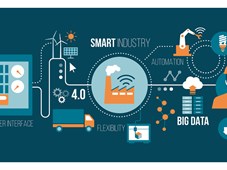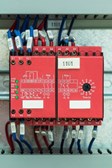Factory Automation, Industry 4.0, and Switches: Part 1
By Mike Bolduc | June 12, 2017

The Internet of things (IoT) trend is impacting almost every facet of modern life, ranging from smart homes to smart cities. One area which appears to hold promise for real gains in efficiency and productivity is the smart factory. Commonly referred to as “Industry 4.0”, the goal is to combine factory automation devices (the “hardware”) to information technology (IT) platforms such as manufacturing execution systems (MES), enterprise resource planning (ERP) and business intelligence (BI) systems in order to provide greater flexibility and higher efficiency to manufacturing companies.
The trend has spawned a number of fancy new buzzwords and terminology in the manufacturing industry.
Starting with the hardware which carries out all the work, there are fieldbus networks (similar to the local area networks that connect desktop computers) which link the sensors, actuators, and controllers on automated equipment. Fieldbus networks are known under many names including DeviceNet, HART, and Profibus, as well as the newer Ethernet based platforms such as EtherCat and Profinet. These local hardware systems link to wireless and cellular networks through gateways and routers, commonly called “edge devices”. The Cloud based data generated is used to manage scheduling and other priorities among globally dispersed factories, and vendors have emerged to manage these device networks and systems, advertising themselves as a platforms as a service (PaaS).
But with all the excitement around the software platforms, communication protocols, and Cloud networks, it’s easy to forget about the foundation of industry 4.0; the hardware.
High volume assembly for many products (such as iPhones) is more economically done on automatic assembly equipment than by human operators. These machines typically use a motorized belt or indexing table to move the product from one station to another, adding and modifying various components until it’s fully assembled. The basic components of these systems include sensors, actuators, and control systems.
Sensors
Before anything happens on the equipment, there is a need to make sure all the components and fixtures are in the correct locations. In addition, for safety reasons, the machine needs to know if any people are in areas where they could be injured. These functions are carried out by a number of different devices including basic snap switches, capacitive and inductive proximity sensors, and photoelectric or light sensors. For the safety circuit, there are dedicated relays which monitor the inputs from emergency stop buttons and light curtains. Vacuum grippers, commonly used to grab and place small components, also require the use of pressure switches to assure the components have been placed correctly. The sensors and switches used for these functions generally need to have small form factors and be able to withstand the harshness of a manufacturing environment.
These devices also need to be configured for things like sensitivity, delays, limits, etc when the machine is put in service or when changes are made. Typical switches are used for this function include tact and DIP switches. These “configuration” switches need to have small footprints, be able to withstand exposure to oils, grease, and other chemicals, perform reliably for many cycles - and have low power consumption. The miniature tact switches used on proximity and pressure sensors must also have appropriate haptics to make it easy for technicians to set up and configure the device.
In Part 2 of this blog, we’ll look at the actuators which carry out the work as well as the last and most critical component of factory automation equipment; the control system.
 |
 |
| Typical safety circuit relay showing rotary switch | C&K RTE series rotary DIP switch |

Mike Bolduc
Global Segment Manager
Industrial & Medical
